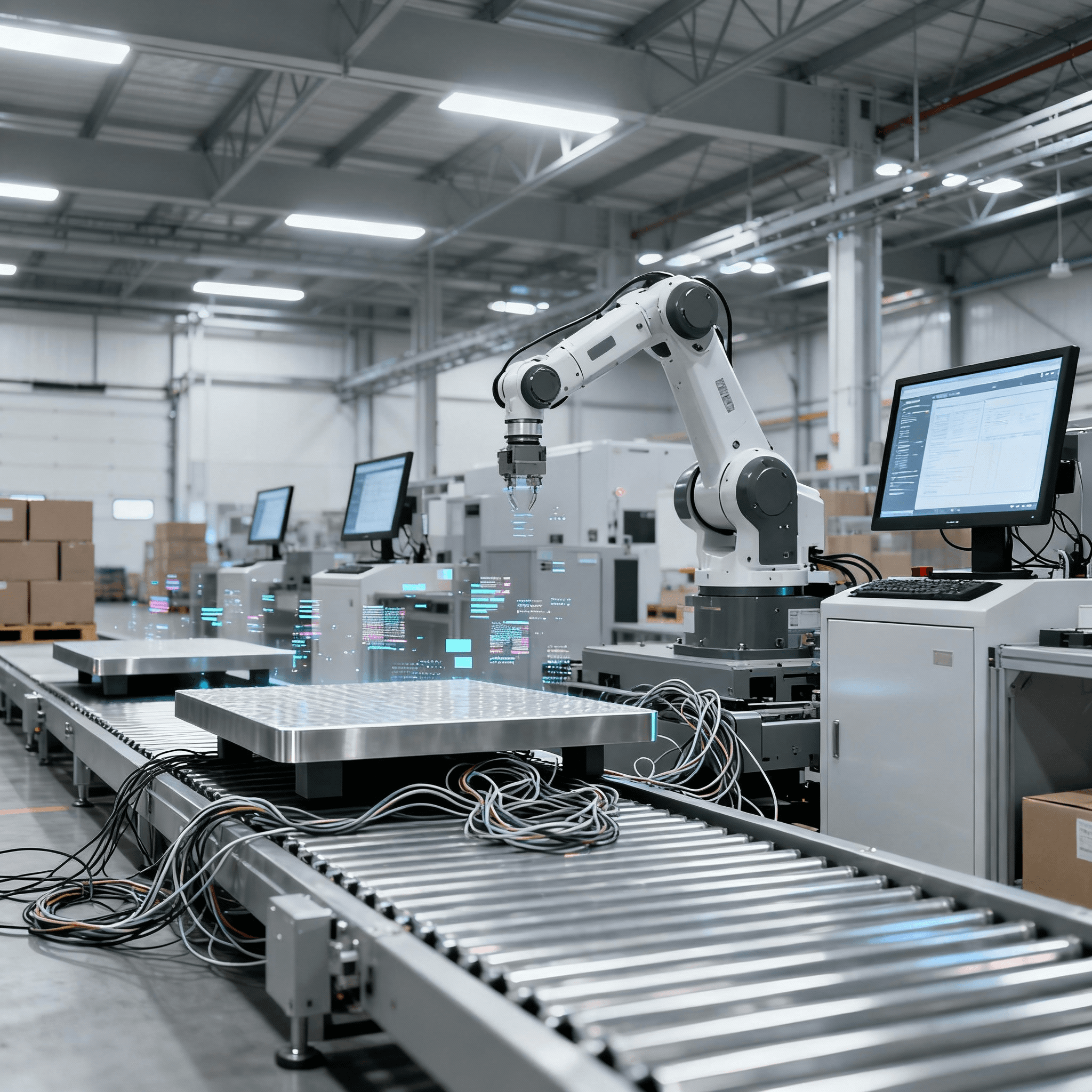What Are the Biggest Challenges or Barriers to Adopting AI in Logistics?
Saturday, 4 Oct 2025
|
As Artificial Intelligence (AI) continues to reshape industries across the globe, the logistics sector is no exception. With its ability to optimize routes, forecast demand, automate warehouses, and enhance customer service, AI promises to revolutionize supply chain operations. However, despite the clear benefits, many logistics companies face significant challenges when it comes to adopting AI technology.
In this blog, we'll explore the biggest barriers logistics companies encounter when implementing AI solutions, and how you can navigate them to unlock the full potential of AI in your business.
1. High Initial Investment and ROI Uncertainty
Why It Matters:
One of the most significant barriers to AI adoption in logistics is the high initial investment required. AI technologies often demand significant upfront capital for purchasing software, hardware, and hiring skilled professionals to integrate and manage the systems. For many logistics companies, especially smaller ones, this investment can seem daunting.
How It Works:
While the long-term benefits of AI are clear—improved efficiency, reduced operational costs, and enhanced customer satisfaction—the initial costs can be a challenge. Many logistics companies struggle to justify the ROI of these technologies when they cannot see immediate returns.
Overcoming the Challenge:
Companies can begin their AI journey with smaller, more affordable projects that offer quick wins, such as implementing AI for demand forecasting or predictive maintenance. By demonstrating ROI early on, businesses can build confidence and gradually expand their AI capabilities.
Real-World Example:
DHL began integrating AI into their operations with a pilot program for predictive maintenance and process automation. By focusing on cost-effective AI solutions that offered immediate value, DHL was able to scale their AI initiatives over time, proving the ROI at each stage.
2. Lack of Skilled Workforce
Why It Matters:
The adoption of AI in logistics requires skilled professionals who understand how to manage, integrate, and optimize AI systems. However, the logistics industry is facing a significant talent shortage in AI, machine learning, and data science. Without the right expertise, even the most advanced AI tools may go underutilized or fail to deliver results.
How It Works:
Logistics companies often struggle to recruit data scientists, AI engineers, and machine learning specialists. Furthermore, there is a shortage of professionals who understand the unique challenges of the logistics industry and can build AI systems that cater to its specific needs.
Overcoming the Challenge:
Logistics companies can bridge this gap by offering internal training programs, partnering with universities, and hiring external consultants to help with AI integration. Another approach is to leverage no-code or low-code AI platforms that allow non-technical users to develop AI solutions.
Real-World Example:
Maersk, a global leader in shipping, addressed this challenge by partnering with educational institutions to create an internal AI training program for their employees. This initiative helped them build an internal team capable of managing and scaling AI projects.
3. Data Quality and Availability
Why It Matters:
AI models rely heavily on data to function effectively. However, logistics companies often struggle with inconsistent, incomplete, or siloed data. Many systems within a supply chain do not communicate with each other, resulting in fragmented data that is difficult to analyze and use for AI-driven decision-making.
How It Works:
For AI systems to work properly, they need clean, high-quality data. In the logistics industry, data is often scattered across various platforms, such as warehouse management systems, transportation management systems, and inventory management tools. Integrating and cleansing this data is a time-consuming and costly process.
Overcoming the Challenge:
To overcome this, logistics companies must invest in data integration and data governance systems. Standardizing data formats and ensuring seamless communication between different systems can provide AI algorithms with the high-quality, comprehensive data they need to operate efficiently.
Real-World Example:
FedEx implemented AI-powered tools that collect and analyze data from across their supply chain. By integrating data from multiple sources, FedEx was able to create a single data hub that fed into their AI models, enabling smarter decision-making.
4. Resistance to Change and Organizational Culture
Why It Matters:
Adopting AI often requires a cultural shift within an organization. Employees may be resistant to the idea of AI replacing jobs or changing their workflow. Additionally, many logistics companies are deeply rooted in traditional practices, and senior leadership may be hesitant to invest in disruptive technology without fully understanding its potential.
How It Works:
The fear of job displacement, a lack of understanding of AI’s benefits, and the discomfort of transitioning to new technologies can create a barrier to adoption. Employees may also worry that AI will not align with their established processes, leading to inefficiencies during the transition.
Overcoming the Challenge:
Leaders must promote a culture of innovation and highlight how AI can enhance employee productivity rather than replace jobs. Providing training programs, addressing employee concerns, and showcasing the benefits of AI can foster a more AI-friendly culture.
Real-World Example:
XPO Logistics took a proactive approach to this challenge by involving their employees in the AI adoption process. They emphasized how AI could assist employees in their daily tasks, such as helping warehouse workers optimize routes and increase efficiency without replacing their roles.
5. Integration with Legacy Systems
Why It Matters:
Many logistics companies rely on legacy systems that are not compatible with modern AI technologies. The complexity of integrating AI with these systems can be a significant barrier, as it often requires overhauling or completely replacing outdated infrastructure.
How It Works:
AI tools need to integrate seamlessly with existing systems like warehouse management systems (WMS), transportation management systems (TMS), and enterprise resource planning (ERP) software. Legacy systems may not have the necessary interfaces or flexibility to work with modern AI solutions.
Overcoming the Challenge:
To tackle this challenge, logistics companies can work with third-party AI providers that specialize in system integration. Starting with modular, scalable AI solutions that are designed for easy integration with existing systems can help smooth the transition.
Real-World Example:
C.H. Robinson addressed this challenge by working with AI vendors to ensure that their AI systems integrated seamlessly with their legacy TMS. This allowed them to gradually adopt AI without disrupting existing operations.
Conclusion: Overcoming AI Adoption Barriers in Logistics
While there are significant barriers to adopting AI in logistics, they are not insurmountable. By addressing the challenges of high initial investment, lack of skilled talent, poor data quality, resistance to change, and integration with legacy systems, logistics companies can unlock the immense potential of AI to drive speed, efficiency, and profitability across their supply chains.
AI is no longer a luxury; it’s a necessity for staying competitive in an increasingly fast-paced market. The key to successful AI adoption lies in incremental implementation, strategic partnerships, and fostering an organizational culture that embraces change.
Ready to Overcome Your AI Barriers?
Discover how AI can transform your logistics operations by booking a personalized demo. Book a Demo.
For more insights on overcoming common challenges in AI, check out our previous blogs on AI-Powered Circular Supply Chains and How Predictive Analytics Works for Logistics.
All blog posts
View All →
Friday, 28 Nov 2025
The 90-Day Roadmap: Moving from Ad-Hoc AI to Operational Excellence
Stuck in AI experimentation? Learn how to escape Level 2 maturity using the Mess-O-Meter to diagnose chaos, prioritize with triangulation, and scale in 90 days.

Thursday, 27 Nov 2025
Mess-O-Meter Deep Dive: Real Logistics Examples for Digital Maturity
Discover Mess-O-Meter examples diagnosing digital chaos in logistics—baseline workflows, benchmark maturity, create AI roadmaps with real steps for transformation success.

Wednesday, 26 Nov 2025
Multi-Agent AI via Email: End-to-End Automation for Logistics Complexity
Explore agentic orchestration where autonomous email AI agents coordinate freight, customs, insurance, and carriers—automating multi-party processes for resilient supply chains.